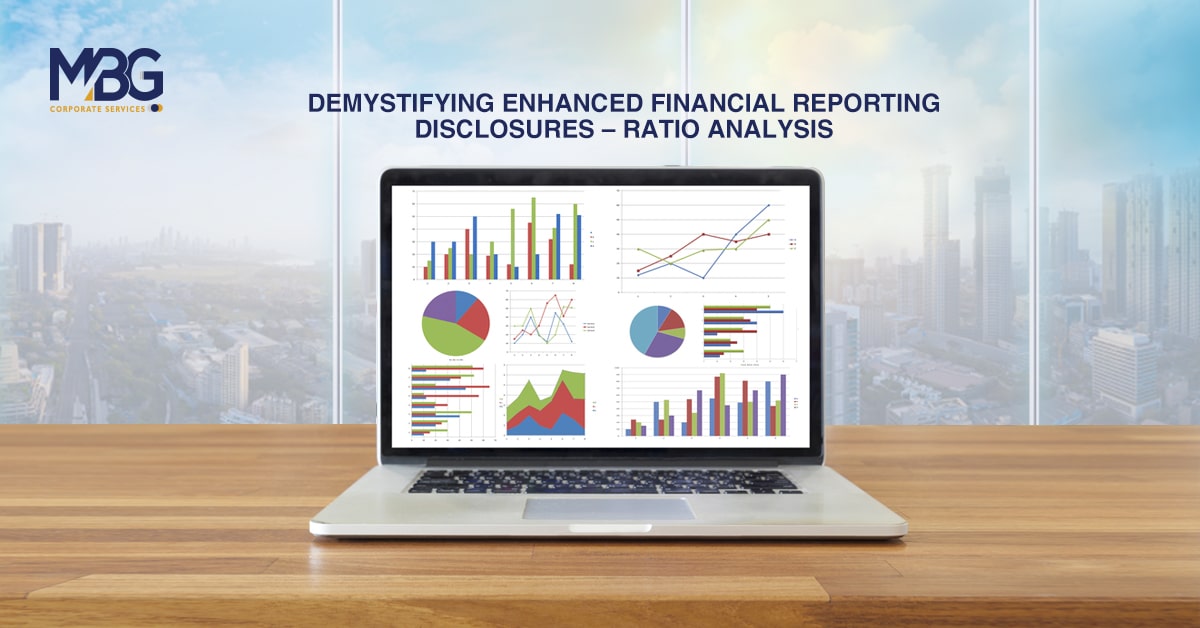Demystifying Enhanced Financial Reporting Disclosures – Ratio Analysis
June 22, 2022

With the ever-increasing stringency in the regulatory framework and disclosure requirements under various provisions of law, the Ministry of Corporate Affairs (“MCA”), vide notification dated March 24, 2021, has further prescribed a list of numerous additional disclosures required in the financial statements by amending schedule III to the Companies Act, 2013.
One of the new requirements is that the company shall disclose the 11 ratios in the financial statement and explain the financial statement line items included in the numerator and denominator for computing the following ratios:
(1) Current ratio
(2) Debt-equity ratio
(3) Debt service coverage ratio
(4) Return on equity ratio
(5) Inventory turnover ratio
(6) Trade receivables turnover ratio
(7) Trade payables turnover ratio
(8) Net capital turnover ratio
(9) Net profit ratio
(10) Return on capital employed
(11) Return on investment
Note: The Company shall explain the items included in the numerator and denominator for computing the above ratios. The explanation shall be provided for any change in the ratio by more than 25% as compared to the preceding year.
The above requirements for disclosures of key ratios are welcome for better understanding and analysis of financial statements.
Cash flows related ratios- i.e. Ratios derived from the cash flow statement of the company
- Current cash debt ratio or cash flow coverage ratio (Net Cash from Operating Activities ÷ Average Current Liabilities)
- This ratio measures cash from operating activities to average current liabilities, which reflects the ability of operations to generate cash that can be used to cover debts that need to be paid within a year \ time.
- Cash flows coverage ratio, (Cash Flow from Operations ÷ Total Debt), which measures the solvency of a company. I.e. the ability to pay off debts.
Combined, these ratios communicate the effectiveness of a business\ operations and demonstrate solvency (paying off long-term debts) and liquidity (paying off short-term debts).
Why are Cash flow ratios required?
- To fully understand a company's viability as an ongoing concern,
- When it comes to liquidity analysis, cash flow information is more reliable than balance sheet or income statement information. Balance sheet data are static—measuring a single point in time—while the income statement contains many arbitrary noncash allocations—for example, pension contributions and depreciation and amortization. In contrast, the cash flow statement records the changes in the other statements and nets out the bookkeeping artifice, focusing on what shareholders really care about: cash available for operations and investments.
- Credit rating agencies, market research experts, lenders, investors, and potential investors have been using ratios to mine cash flow statements for practical revelations. That's because, over time, free cash flow ratios help people gauge a company's ability to withstand cyclical downturns, price wars, financial distress, Covid-like black swan events, etc.
CALCULATION/ FORMULAS:
The calculation of such a ratio is explained here-in-under:
(1) CURRENT RATIO:
The Current Ratio is one of the best-known measures of short-term solvency. It is the most common measure of short-term liquidity.
The main question this ratio address is: "Does your business have enough current assets to meet the payment schedule of its current debts with a margin of safety for possible losses in current assets?"
Current Ratio = Current Assets / Current Liabilities
Where,
| Current Assets | = | Inventories + Sundry Debtors + Cash and Bank Balances + Receivables/ Accruals + Loans and Advances + Disposable Investments + Any other current assets. |
| Current Liabilities | = | Creditors for goods and services + Short-term Loans + Bank Overdraft + Cash Credit + Outstanding Expenses + Provision for Taxation + Proposed Dividend + Unclaimed Dividend + Any other current liabilities. |
Interpretation
A generally acceptable current ratio is 2:1. But whether or not a specific ratio is satisfactory depends on the nature of the business and the characteristics of its current assets and liabilities.
(2) DEBT-EQUITY RATIO:
This ratio indicates the proportion of debt funds in relation to equity.
Debt-Equity Ratio = Total Debts / Shareholder’s Equity
Where,
Total debt includes short and long-term borrowings from financial institutions, debentures/bonds, deferred payment arrangements for buying capital equipment, bank borrowings, public deposits, and any other interest-bearing loan.
The shareholders’ Equity is equity and preference share capital + post accumulated profits (excluding fictitious assets etc).
Interpretation
A high debt-to-equity ratio here means less protection for creditors, a low ratio, on the other hand, indicates a wider safety cushion (i.e., creditors feel the owner's funds can help absorb possible losses of income and capital). Lenders are also very keen to know this ratio since it shows the relative weights of debt and equity.
(3) DEBT SERVICE COVERAGE RATIO:
Lenders are interested in debt service coverage to judge the firm’s ability to pay off current interest and installments.
Debt Service Coverage Ratio = Earnings available for debt services/ Interest + Principal Repayments
Where,
Earning for debt service = Net profit before tax + Non-cash operating expenses like depreciation and other amortizations + Interest + other adjustments like loss on sale of Fixed Assets etc.
Interpretation
Normally Debt Service Coverage Ratio of 1.5 to 2 is normally considered satisfactory.
4) RETURN ON EQUITY RATIO:
Return on Equity measures the profitability of equity funds invested in the firm. This ratio reveals how profitably the owners’ funds have been utilized by the firm. It also measures the percentage return generated to equity shareholders. Return on equity is one of the most important indicators of a firm’s profitability and potential growth. Companies that boast a high return on equity with little or no debt are able to grow without large capital expenditures, allowing the owners of the business to withdraw cash and reinvest it elsewhere. Many investors fail to realize, however, that two companies can have the same return on equity, yet one can be a much better business. This ratio is computed as:
ROE = Net Profit after taxes -Preference dividend (if any) / Average Shareholders’ Equity ×100
Where,
Average Shareholders’ Equity = (Beginning shareholders' equity + Ending shareholders' equity) ÷ 2
(5) INVENTORY TURNOVER RATIO:
This ratio also known as the stock turnover ratio establishes the relationship between the cost of goods sold during the year and the average inventory held during the year. It measures the efficiency with which a firm utilizes or manages its inventory. It is calculated as follows:
Inventory Turnover Ratio = Cost of Goods Sold or Sales / Average Inventory
Where,
Cost of Goods Sold = Opening Stock + Net Purchase - Closing Stock + Direct Labour + Direct Expenses (note: selling and administrative expenses are normally excluded)
Average Inventory = (Opening Stock + Closing Stock) ÷ 2
(6) TRADE RECEIVABLE TURNOVER RATIO:
In case a company sells goods on credit, the realization of sales revenue is delayed and the receivables are created. The cash is realized from these receivables later on. The speed with which these receivables are collected affects the liquidity position of the company. The Trade Receivables Turnover ratio throws light on the collection and credit policies of the Company. It measures the efficiency with which management is managing its accounts receivables. It is calculated as follows:
Trade Receivable Turnover Ratio = Net Credit Sales / Average Account Receivable
Where,
Net credit sales consist of gross credit sales minus sales return.
Trade receivables include sundry debtors and bill receivables.
Average trade receivable = (Opening trade receivables+ Closing trade receivables) ÷ 2
(7) TRADE PAYABLE TURNOVER RATIO:
It indicates the number of times sundry creditors have been paid during a period. It is calculated to judge the requirements of cash for paying sundry creditors. It is calculated by dividing the net credit purchases by average creditors. It is calculated as follows:
Trade Payable Turnover Ratio = Net Credit Purchase / Average Account Payable
Where,
Net credit purchase consists of gross credit purchase minus purchase return.
Average trade payable = (Opening trade payables+ Closing trade payables) ÷ 2
Interpretation
A low creditor’s turnover ratio reflects liberal credit terms granted by suppliers, while a high ratio shows that accounts are settled rapidly.
(8) NET CAPITAL TURNOVER RATIO:
It indicates a company's effectiveness in using its working capital.
Net Capital Turnover Ratio = Net Sale / Average Working Capital
Where,
Net Sales shall be calculated as total sales minus sales returns.
Working Capital = Current Assets – Current Liabilities
Average Working Capital = (Opening working capital + Closing working capital) ÷ 2
(9) NET PROFIT RATIO
It measures the relationship between net profit and sales of the business. It can be calculated as:
Net Profit Ratio = Net Profit after tax / Sales ×100
Where,
Net profit shall be after tax.
Net sales shall be calculated as total sales minus sales returns
Interpretation
The net profit ratio finds the proportion of revenue that finds its way into profits. A high net profit ratio will ensure positive returns for the business
(10) RETURN ON CAPITAL EMPLOYED :
Return on capital employed indicates the ability of a company’s management to generate returns for both the debt holders and the equity holders. The higher the ratio, the more efficiently the capital is employed by the company to generate returns.
Return on Capital Employed Ratio = Earning before interest and taxes / Average Working Capital
Where,
Capital Employed = Tangible Net Worth* + Total Debt + Deferred Tax Liability
*Tangible Net Worth = Total Asset – Total Liabilities – Intangible Assets
(11) RETURN ON INVESTMENT :
ROI is the most important ratio of all. It is the percentage of return on funds invested in the business by its owners. In short, this ratio tells the owner whether or not all the effort put into the business has been worthwhile. It compares earnings/ returns/ profit with the investment in the company. The ROI is calculated as follows:
Return on Investment = Profit before interest and taxes / Investment ×100
Where,
Investment may be Total Assets or Net Assets.
CONCLUSION:
If we sum up the above discussion, the requirement of ratio analysis as per required amended Schedule III is intended to increase transparency and reliability of financial statement users, which is critical because, as we can see in today’s era, investor confidence in financial statements is dwindling due to an increase in instances of fraud and non-compliance, which has resulted in the collocation of funds.
The objective of ratios is that all stakeholders (owners, investors, lenders, employees, etc.) can draw conclusions about the
- Performance (past, present, and future);
- Strengths & weaknesses of a firm; and
- Can take decisions in relation to the firm.
Ratio analysis is based on the fact that a single accounting figure by itself may not communicate any meaningful information but when expressed relative to some other figure, it may definitely provide some significant information. Ratio analysis is not just comparing different numbers from the balance sheet, income statement, and cash flow statement. It is comparing the number against previous years, other companies, the industry, or even the economy in general for the purpose of financial analysis.








